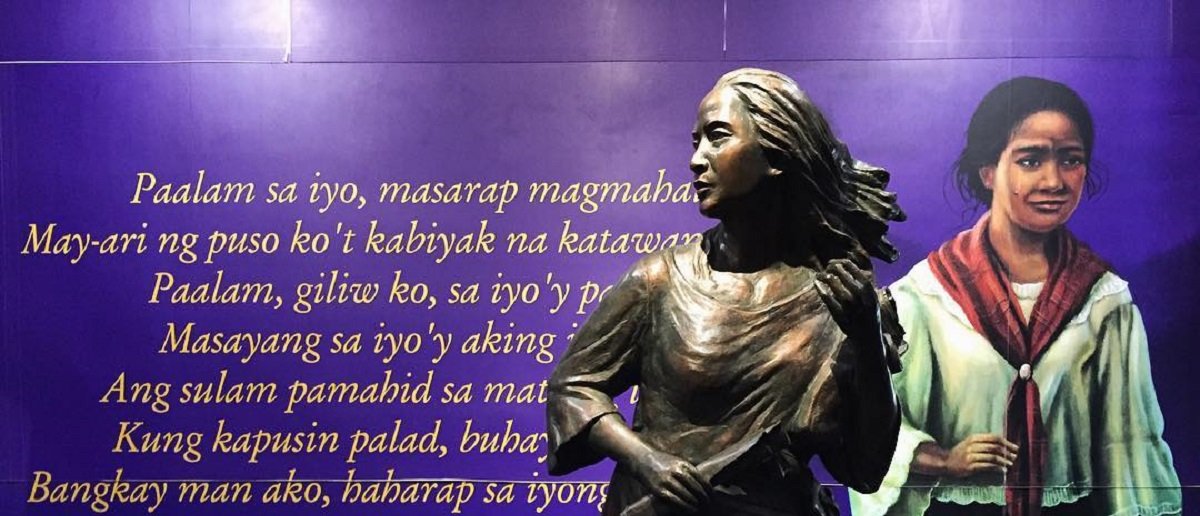A writer and lyricist with dreams taller than herself.
There’s a reason the Philippines is called Inang Bayan.
In Juan Luna’s sublime SpoliarIum, we see Inang Bayan weeping for the fallen and the dying. On Peter De Guzman’s Memorare – Manila 1945, she cradles her child in her arms and offers a distraught sense of comfort to the other suffering figures surrounding her. But at the very top of Guillermo Tolentino’s Monumento, she stands in resolute strength and revolutionary triumph.
These works of art, and so many more, are all inspired by the struggles that our Inang Bayan faced and defeated throughout the centuries.
Nobody represents her tumultuous journey better than Gregoria Álvarez de Jesús, the Lakambini of the Katipunan.
Who is Gregoria Álvarez de Jesús?
Gregoria Álvarez de Jesús is more commonly known as Aling Oriang, the wife of Gat Andres Bonifacio. But even though her husband was the Supremo of the Katipunan and the President of the Katagalugan Revolutionary Government, she, too, had a prominent role in the Philippine Revolution.
Oriang was born on May 9, 1875 in the town of Kalookan. She was 18 years old when she met the 29-year-old Andres Bonifacio, an intelligent and radical leader of a secret society.
Her father was initially against their relationship because Bonifacio was a Freemason. But after many months of courtship, they eventually got her parents’ approval. They had a traditional wedding in 1893 at the Binondo Church followed by a Katipunero ceremony a week later.
From there, Oriang effortlessly stepped into her role of Lakambini.
One of the first things on Oriang’s agenda was to establish a women’s chapter of the Katipunan.
In addition to being this chapter’s founder and vice president, she served as the custodian of the organization’s seal and documents. Whenever the Guardia Civil would make surprise house inspections, she would take all documents and drive around town in a calesa until it was deemed safe to return home.
As devoted as she was to the society, she also had a family to look after. She and Bonifacio had a son who died of smallpox as an infant. Even through the grief, the married couple understood their duty to their country and their desire for Philippine independence. Life had to go on.
The Supremo and the Lakambini had to be strong because of what was to come.
The brave and alert Oriang was reverently called Ina ng Himagsikan and Lakambini ng Katipunan. She fought alongside her husband during the darkest times of the revolution. This was amplified when Teodoro Patino exposed the Katipunan and the Spanish government took action.
It didn’t help that there were conflicts between the Magdiwang and Magdalo factions of the Katipunan. Emilio Aguinaldo’s Magdalo faction, which comprised Ilustrados from Cavite, couldn’t see eye-to-eye with Bonifacion’s Magdiwang faction, made up of rebels from Manila.
This further weakened the Katipunan and led to the ultimate tragedy of Oriang’s life.
Aguinaldo’s men captured the Supremo, the Lakambini, and some of their cohorts. Bonifacio was shot in the arm and stabbed in the neck. His brothers were beaten and shot dead. Oriang was presumably raped by an Aguinaldo loyalist. She was only 22 years old at the time.
After a bogus trial meant to secure Aguinaldo’s total control of the Katipunan, the Bonifacio brothers were sentenced to death. They were repeatedly hacked with a bolo on May 10, 1987. Their bodies were carelessly buried somewhere on Mt. Tala in Maragondon, Cavite.
Oriang’s grief remains tangible today. But she knew her duty to her country.
The courageous Lakambini continued to fight for freedom against the Spaniards. She later on settled down with another patriot from the Katipunan, Julio Nakpil. They had six children. She lived peacefully, instilling patriotism in the hearts of her children, until she passed away on March 15, 1943.
How can Modern Filipinas continue her legacy?
“I had no fear of danger,” Oriang recounted in her autobiography. “Not even death itself […] I was then by no other desire than to see unfurled the flag of an independent Philippines.” She candidly shared her surprise in how she survived everything that happened throughout her youth.
We face very different challenges today.
But if the Lakambini of the Katipunan were still here today, there’s no doubt that she would be front and center, fighting for what she knows is right.
The Philippines is by no means an easy place to live. Filipinos fight many social and political battles every day. We aren’t new to internal struggles that are heavily affected by our communities, either. But always, through prudence and patience and perseverance, truth and justice will prevail.
Continue to fight with Oriang’s strength and sense of duty, Modern Filipina.


